HI6006 Report: Competitive & Cooperative Strategy of IKEA Thailand
VerifiedAdded on 2023/06/11
|11
|2843
|164
Report
AI Summary
This report provides an analysis of IKEA Thailand's competitive strategy, with a focus on its cooperative strategies. It begins with a company background, highlighting IKEA's value-driven approach and global presence. The report then delves into the meaning and importance of cooperative strategies, explaining how IKEA Thailand has successfully utilized these strategies to gain a competitive advantage in the Thai market. It further examines the competitive dynamics of the industry, including the challenges and opportunities faced by IKEA. The report concludes that IKEA's cooperative strategies, particularly its focus on stakeholders and strategic alliances, have been instrumental in its success in Thailand.
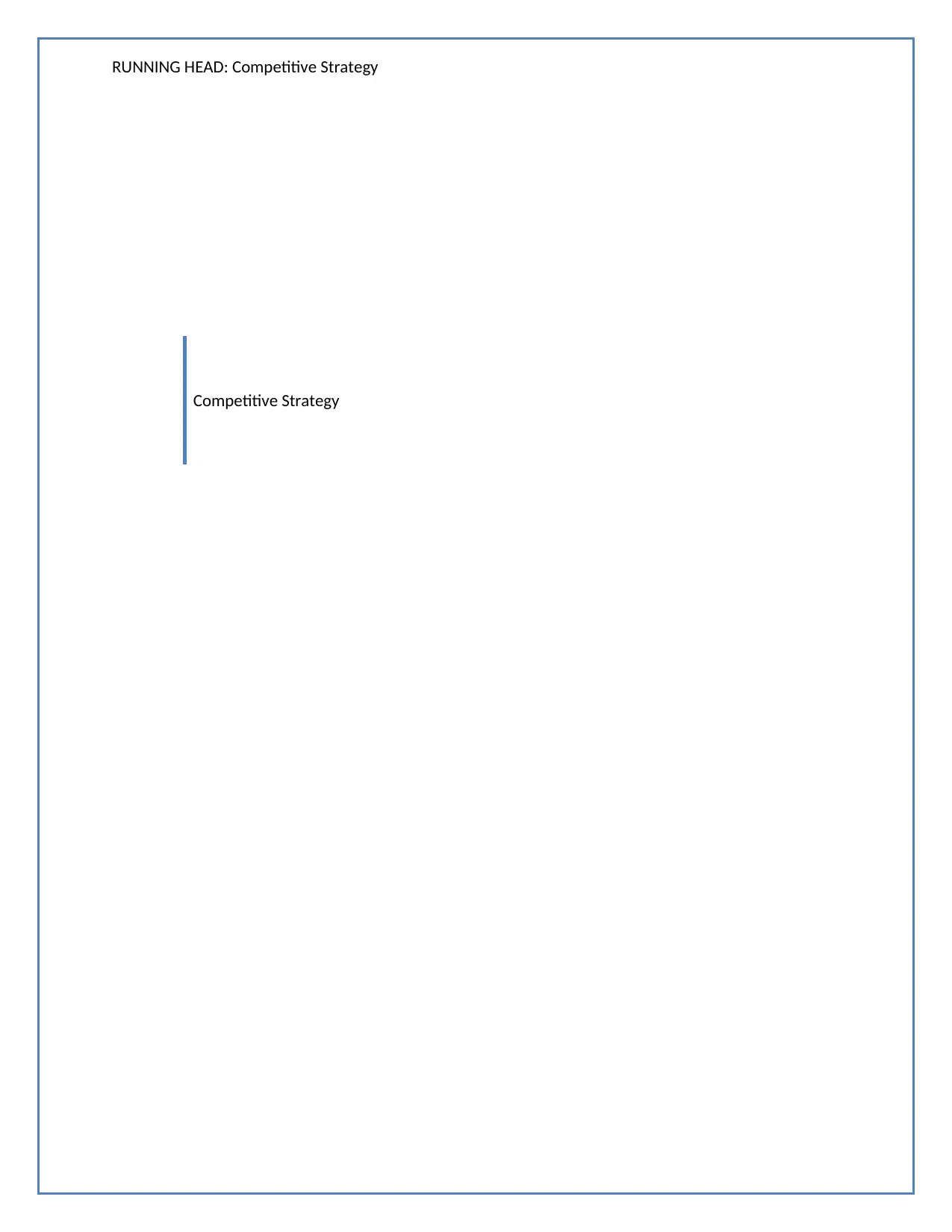
RUNNING HEAD: Competitive Strategy
Competitive Strategy
Competitive Strategy
Paraphrase This Document
Need a fresh take? Get an instant paraphrase of this document with our AI Paraphraser
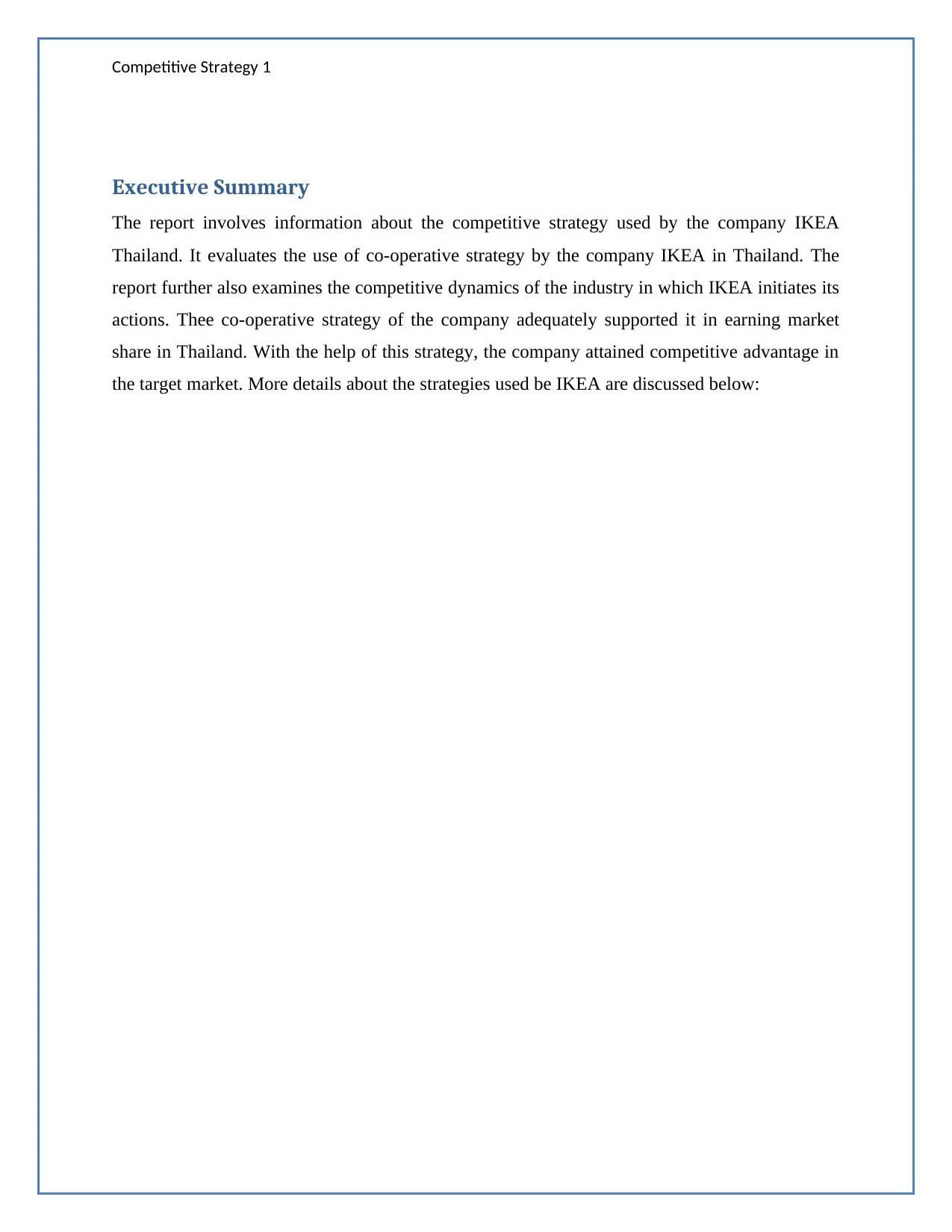
Competitive Strategy 1
Executive Summary
The report involves information about the competitive strategy used by the company IKEA
Thailand. It evaluates the use of co-operative strategy by the company IKEA in Thailand. The
report further also examines the competitive dynamics of the industry in which IKEA initiates its
actions. Thee co-operative strategy of the company adequately supported it in earning market
share in Thailand. With the help of this strategy, the company attained competitive advantage in
the target market. More details about the strategies used be IKEA are discussed below:
Executive Summary
The report involves information about the competitive strategy used by the company IKEA
Thailand. It evaluates the use of co-operative strategy by the company IKEA in Thailand. The
report further also examines the competitive dynamics of the industry in which IKEA initiates its
actions. Thee co-operative strategy of the company adequately supported it in earning market
share in Thailand. With the help of this strategy, the company attained competitive advantage in
the target market. More details about the strategies used be IKEA are discussed below:
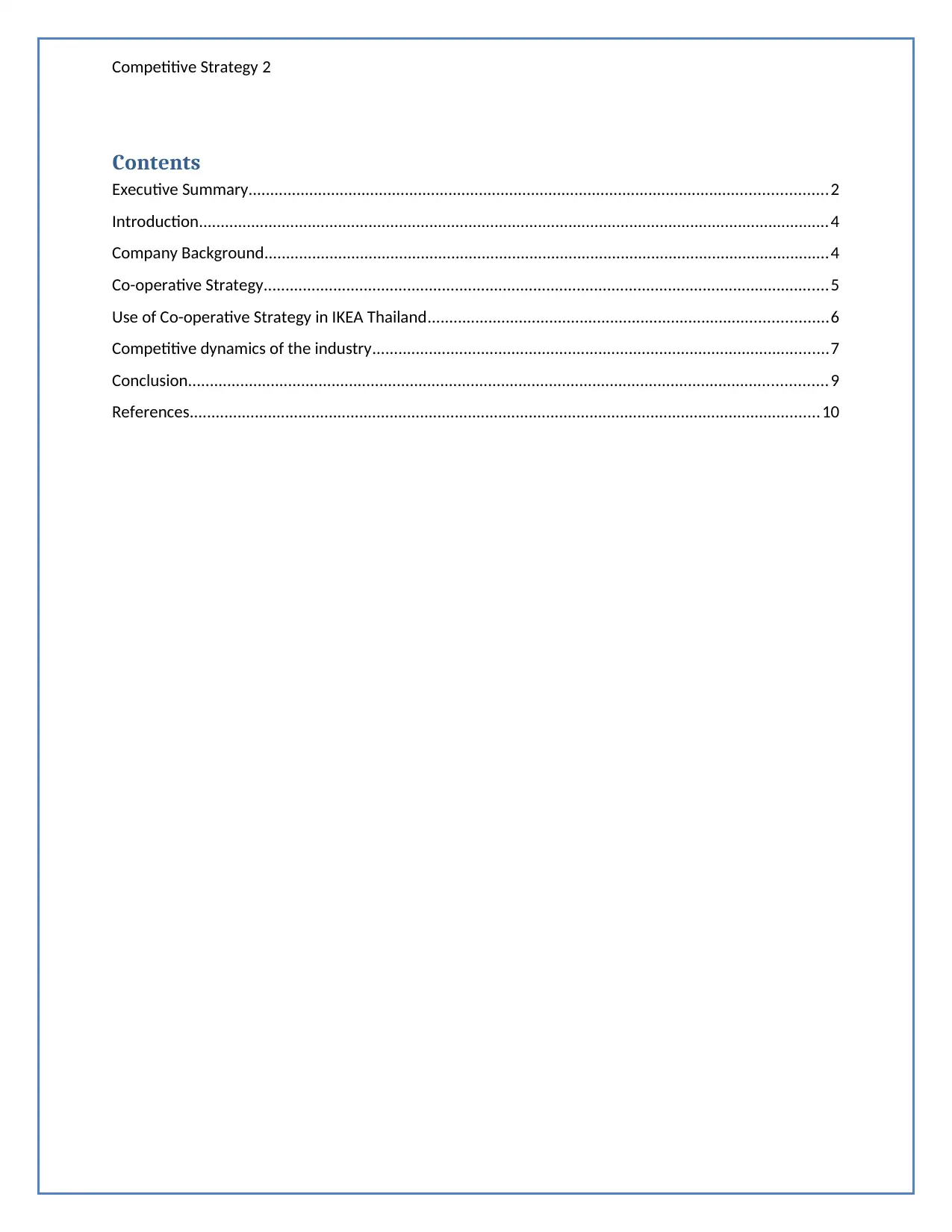
Competitive Strategy 2
Contents
Executive Summary.....................................................................................................................................2
Introduction.................................................................................................................................................4
Company Background..................................................................................................................................4
Co-operative Strategy..................................................................................................................................5
Use of Co-operative Strategy in IKEA Thailand............................................................................................6
Competitive dynamics of the industry.........................................................................................................7
Conclusion...................................................................................................................................................9
References.................................................................................................................................................10
Contents
Executive Summary.....................................................................................................................................2
Introduction.................................................................................................................................................4
Company Background..................................................................................................................................4
Co-operative Strategy..................................................................................................................................5
Use of Co-operative Strategy in IKEA Thailand............................................................................................6
Competitive dynamics of the industry.........................................................................................................7
Conclusion...................................................................................................................................................9
References.................................................................................................................................................10
⊘ This is a preview!⊘
Do you want full access?
Subscribe today to unlock all pages.

Trusted by 1+ million students worldwide
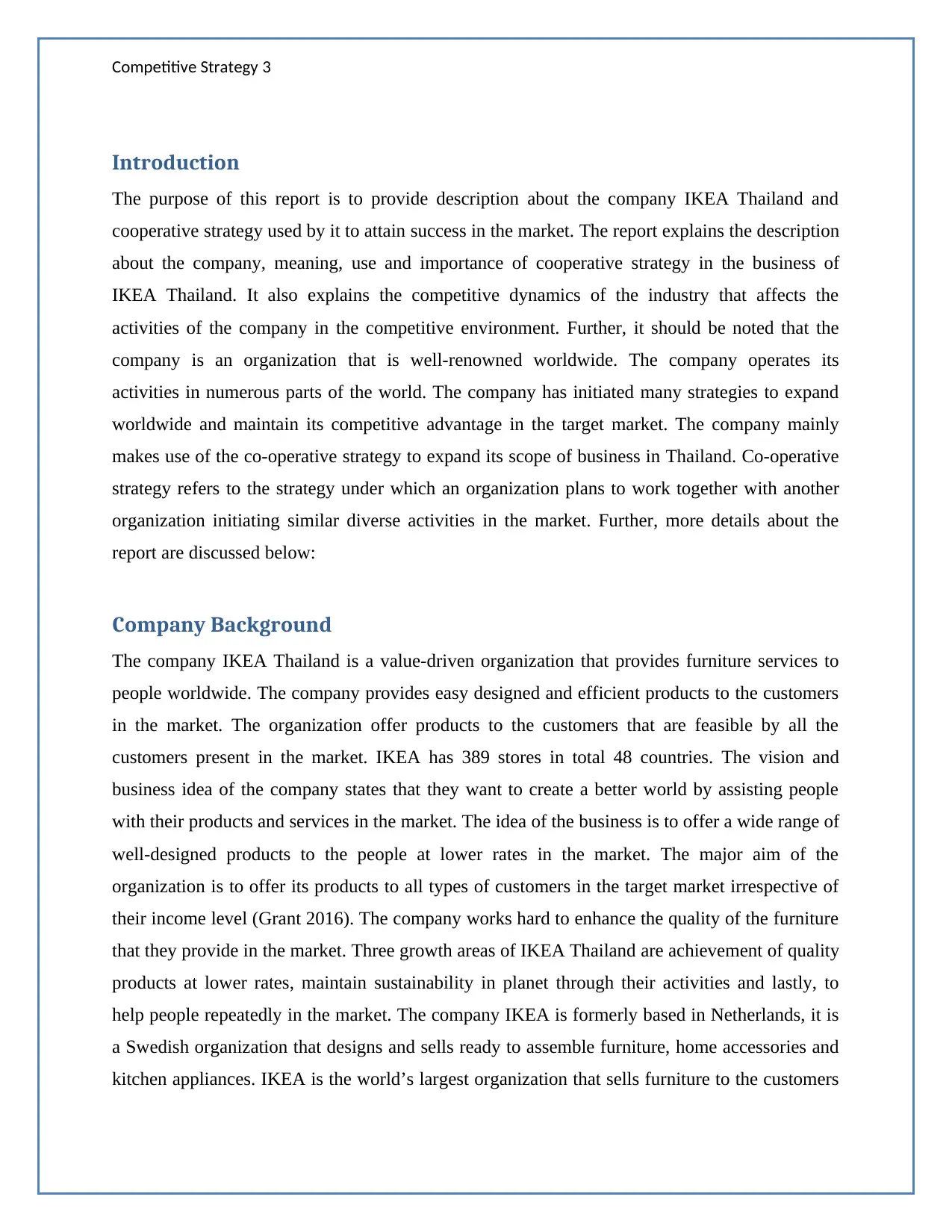
Competitive Strategy 3
Introduction
The purpose of this report is to provide description about the company IKEA Thailand and
cooperative strategy used by it to attain success in the market. The report explains the description
about the company, meaning, use and importance of cooperative strategy in the business of
IKEA Thailand. It also explains the competitive dynamics of the industry that affects the
activities of the company in the competitive environment. Further, it should be noted that the
company is an organization that is well-renowned worldwide. The company operates its
activities in numerous parts of the world. The company has initiated many strategies to expand
worldwide and maintain its competitive advantage in the target market. The company mainly
makes use of the co-operative strategy to expand its scope of business in Thailand. Co-operative
strategy refers to the strategy under which an organization plans to work together with another
organization initiating similar diverse activities in the market. Further, more details about the
report are discussed below:
Company Background
The company IKEA Thailand is a value-driven organization that provides furniture services to
people worldwide. The company provides easy designed and efficient products to the customers
in the market. The organization offer products to the customers that are feasible by all the
customers present in the market. IKEA has 389 stores in total 48 countries. The vision and
business idea of the company states that they want to create a better world by assisting people
with their products and services in the market. The idea of the business is to offer a wide range of
well-designed products to the people at lower rates in the market. The major aim of the
organization is to offer its products to all types of customers in the target market irrespective of
their income level (Grant 2016). The company works hard to enhance the quality of the furniture
that they provide in the market. Three growth areas of IKEA Thailand are achievement of quality
products at lower rates, maintain sustainability in planet through their activities and lastly, to
help people repeatedly in the market. The company IKEA is formerly based in Netherlands, it is
a Swedish organization that designs and sells ready to assemble furniture, home accessories and
kitchen appliances. IKEA is the world’s largest organization that sells furniture to the customers
Introduction
The purpose of this report is to provide description about the company IKEA Thailand and
cooperative strategy used by it to attain success in the market. The report explains the description
about the company, meaning, use and importance of cooperative strategy in the business of
IKEA Thailand. It also explains the competitive dynamics of the industry that affects the
activities of the company in the competitive environment. Further, it should be noted that the
company is an organization that is well-renowned worldwide. The company operates its
activities in numerous parts of the world. The company has initiated many strategies to expand
worldwide and maintain its competitive advantage in the target market. The company mainly
makes use of the co-operative strategy to expand its scope of business in Thailand. Co-operative
strategy refers to the strategy under which an organization plans to work together with another
organization initiating similar diverse activities in the market. Further, more details about the
report are discussed below:
Company Background
The company IKEA Thailand is a value-driven organization that provides furniture services to
people worldwide. The company provides easy designed and efficient products to the customers
in the market. The organization offer products to the customers that are feasible by all the
customers present in the market. IKEA has 389 stores in total 48 countries. The vision and
business idea of the company states that they want to create a better world by assisting people
with their products and services in the market. The idea of the business is to offer a wide range of
well-designed products to the people at lower rates in the market. The major aim of the
organization is to offer its products to all types of customers in the target market irrespective of
their income level (Grant 2016). The company works hard to enhance the quality of the furniture
that they provide in the market. Three growth areas of IKEA Thailand are achievement of quality
products at lower rates, maintain sustainability in planet through their activities and lastly, to
help people repeatedly in the market. The company IKEA is formerly based in Netherlands, it is
a Swedish organization that designs and sells ready to assemble furniture, home accessories and
kitchen appliances. IKEA is the world’s largest organization that sells furniture to the customers
Paraphrase This Document
Need a fresh take? Get an instant paraphrase of this document with our AI Paraphraser
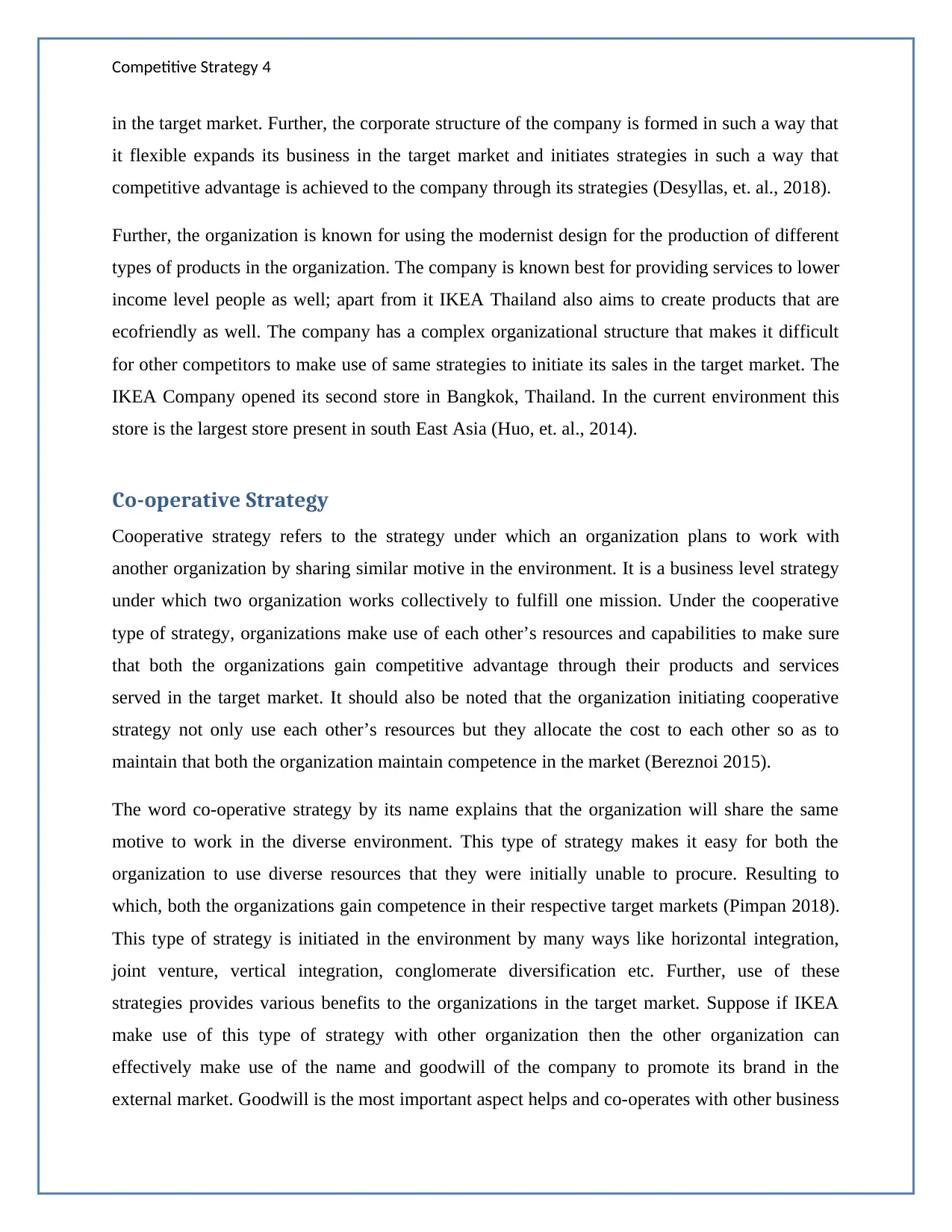
Competitive Strategy 4
in the target market. Further, the corporate structure of the company is formed in such a way that
it flexible expands its business in the target market and initiates strategies in such a way that
competitive advantage is achieved to the company through its strategies (Desyllas, et. al., 2018).
Further, the organization is known for using the modernist design for the production of different
types of products in the organization. The company is known best for providing services to lower
income level people as well; apart from it IKEA Thailand also aims to create products that are
ecofriendly as well. The company has a complex organizational structure that makes it difficult
for other competitors to make use of same strategies to initiate its sales in the target market. The
IKEA Company opened its second store in Bangkok, Thailand. In the current environment this
store is the largest store present in south East Asia (Huo, et. al., 2014).
Co-operative Strategy
Cooperative strategy refers to the strategy under which an organization plans to work with
another organization by sharing similar motive in the environment. It is a business level strategy
under which two organization works collectively to fulfill one mission. Under the cooperative
type of strategy, organizations make use of each other’s resources and capabilities to make sure
that both the organizations gain competitive advantage through their products and services
served in the target market. It should also be noted that the organization initiating cooperative
strategy not only use each other’s resources but they allocate the cost to each other so as to
maintain that both the organization maintain competence in the market (Bereznoi 2015).
The word co-operative strategy by its name explains that the organization will share the same
motive to work in the diverse environment. This type of strategy makes it easy for both the
organization to use diverse resources that they were initially unable to procure. Resulting to
which, both the organizations gain competence in their respective target markets (Pimpan 2018).
This type of strategy is initiated in the environment by many ways like horizontal integration,
joint venture, vertical integration, conglomerate diversification etc. Further, use of these
strategies provides various benefits to the organizations in the target market. Suppose if IKEA
make use of this type of strategy with other organization then the other organization can
effectively make use of the name and goodwill of the company to promote its brand in the
external market. Goodwill is the most important aspect helps and co-operates with other business
in the target market. Further, the corporate structure of the company is formed in such a way that
it flexible expands its business in the target market and initiates strategies in such a way that
competitive advantage is achieved to the company through its strategies (Desyllas, et. al., 2018).
Further, the organization is known for using the modernist design for the production of different
types of products in the organization. The company is known best for providing services to lower
income level people as well; apart from it IKEA Thailand also aims to create products that are
ecofriendly as well. The company has a complex organizational structure that makes it difficult
for other competitors to make use of same strategies to initiate its sales in the target market. The
IKEA Company opened its second store in Bangkok, Thailand. In the current environment this
store is the largest store present in south East Asia (Huo, et. al., 2014).
Co-operative Strategy
Cooperative strategy refers to the strategy under which an organization plans to work with
another organization by sharing similar motive in the environment. It is a business level strategy
under which two organization works collectively to fulfill one mission. Under the cooperative
type of strategy, organizations make use of each other’s resources and capabilities to make sure
that both the organizations gain competitive advantage through their products and services
served in the target market. It should also be noted that the organization initiating cooperative
strategy not only use each other’s resources but they allocate the cost to each other so as to
maintain that both the organization maintain competence in the market (Bereznoi 2015).
The word co-operative strategy by its name explains that the organization will share the same
motive to work in the diverse environment. This type of strategy makes it easy for both the
organization to use diverse resources that they were initially unable to procure. Resulting to
which, both the organizations gain competence in their respective target markets (Pimpan 2018).
This type of strategy is initiated in the environment by many ways like horizontal integration,
joint venture, vertical integration, conglomerate diversification etc. Further, use of these
strategies provides various benefits to the organizations in the target market. Suppose if IKEA
make use of this type of strategy with other organization then the other organization can
effectively make use of the name and goodwill of the company to promote its brand in the
external market. Goodwill is the most important aspect helps and co-operates with other business
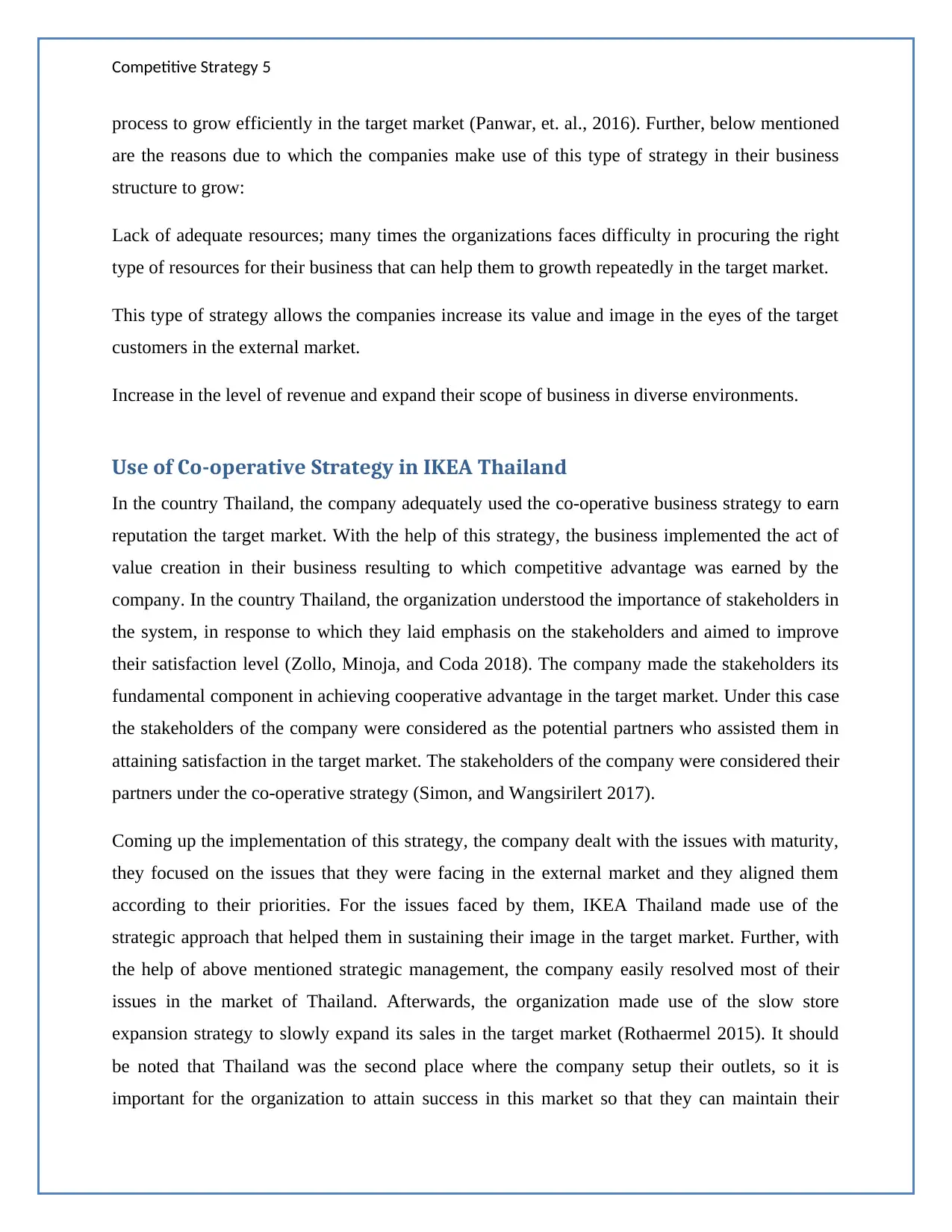
Competitive Strategy 5
process to grow efficiently in the target market (Panwar, et. al., 2016). Further, below mentioned
are the reasons due to which the companies make use of this type of strategy in their business
structure to grow:
Lack of adequate resources; many times the organizations faces difficulty in procuring the right
type of resources for their business that can help them to growth repeatedly in the target market.
This type of strategy allows the companies increase its value and image in the eyes of the target
customers in the external market.
Increase in the level of revenue and expand their scope of business in diverse environments.
Use of Co-operative Strategy in IKEA Thailand
In the country Thailand, the company adequately used the co-operative business strategy to earn
reputation the target market. With the help of this strategy, the business implemented the act of
value creation in their business resulting to which competitive advantage was earned by the
company. In the country Thailand, the organization understood the importance of stakeholders in
the system, in response to which they laid emphasis on the stakeholders and aimed to improve
their satisfaction level (Zollo, Minoja, and Coda 2018). The company made the stakeholders its
fundamental component in achieving cooperative advantage in the target market. Under this case
the stakeholders of the company were considered as the potential partners who assisted them in
attaining satisfaction in the target market. The stakeholders of the company were considered their
partners under the co-operative strategy (Simon, and Wangsirilert 2017).
Coming up the implementation of this strategy, the company dealt with the issues with maturity,
they focused on the issues that they were facing in the external market and they aligned them
according to their priorities. For the issues faced by them, IKEA Thailand made use of the
strategic approach that helped them in sustaining their image in the target market. Further, with
the help of above mentioned strategic management, the company easily resolved most of their
issues in the market of Thailand. Afterwards, the organization made use of the slow store
expansion strategy to slowly expand its sales in the target market (Rothaermel 2015). It should
be noted that Thailand was the second place where the company setup their outlets, so it is
important for the organization to attain success in this market so that they can maintain their
process to grow efficiently in the target market (Panwar, et. al., 2016). Further, below mentioned
are the reasons due to which the companies make use of this type of strategy in their business
structure to grow:
Lack of adequate resources; many times the organizations faces difficulty in procuring the right
type of resources for their business that can help them to growth repeatedly in the target market.
This type of strategy allows the companies increase its value and image in the eyes of the target
customers in the external market.
Increase in the level of revenue and expand their scope of business in diverse environments.
Use of Co-operative Strategy in IKEA Thailand
In the country Thailand, the company adequately used the co-operative business strategy to earn
reputation the target market. With the help of this strategy, the business implemented the act of
value creation in their business resulting to which competitive advantage was earned by the
company. In the country Thailand, the organization understood the importance of stakeholders in
the system, in response to which they laid emphasis on the stakeholders and aimed to improve
their satisfaction level (Zollo, Minoja, and Coda 2018). The company made the stakeholders its
fundamental component in achieving cooperative advantage in the target market. Under this case
the stakeholders of the company were considered as the potential partners who assisted them in
attaining satisfaction in the target market. The stakeholders of the company were considered their
partners under the co-operative strategy (Simon, and Wangsirilert 2017).
Coming up the implementation of this strategy, the company dealt with the issues with maturity,
they focused on the issues that they were facing in the external market and they aligned them
according to their priorities. For the issues faced by them, IKEA Thailand made use of the
strategic approach that helped them in sustaining their image in the target market. Further, with
the help of above mentioned strategic management, the company easily resolved most of their
issues in the market of Thailand. Afterwards, the organization made use of the slow store
expansion strategy to slowly expand its sales in the target market (Rothaermel 2015). It should
be noted that Thailand was the second place where the company setup their outlets, so it is
important for the organization to attain success in this market so that they can maintain their
⊘ This is a preview!⊘
Do you want full access?
Subscribe today to unlock all pages.

Trusted by 1+ million students worldwide
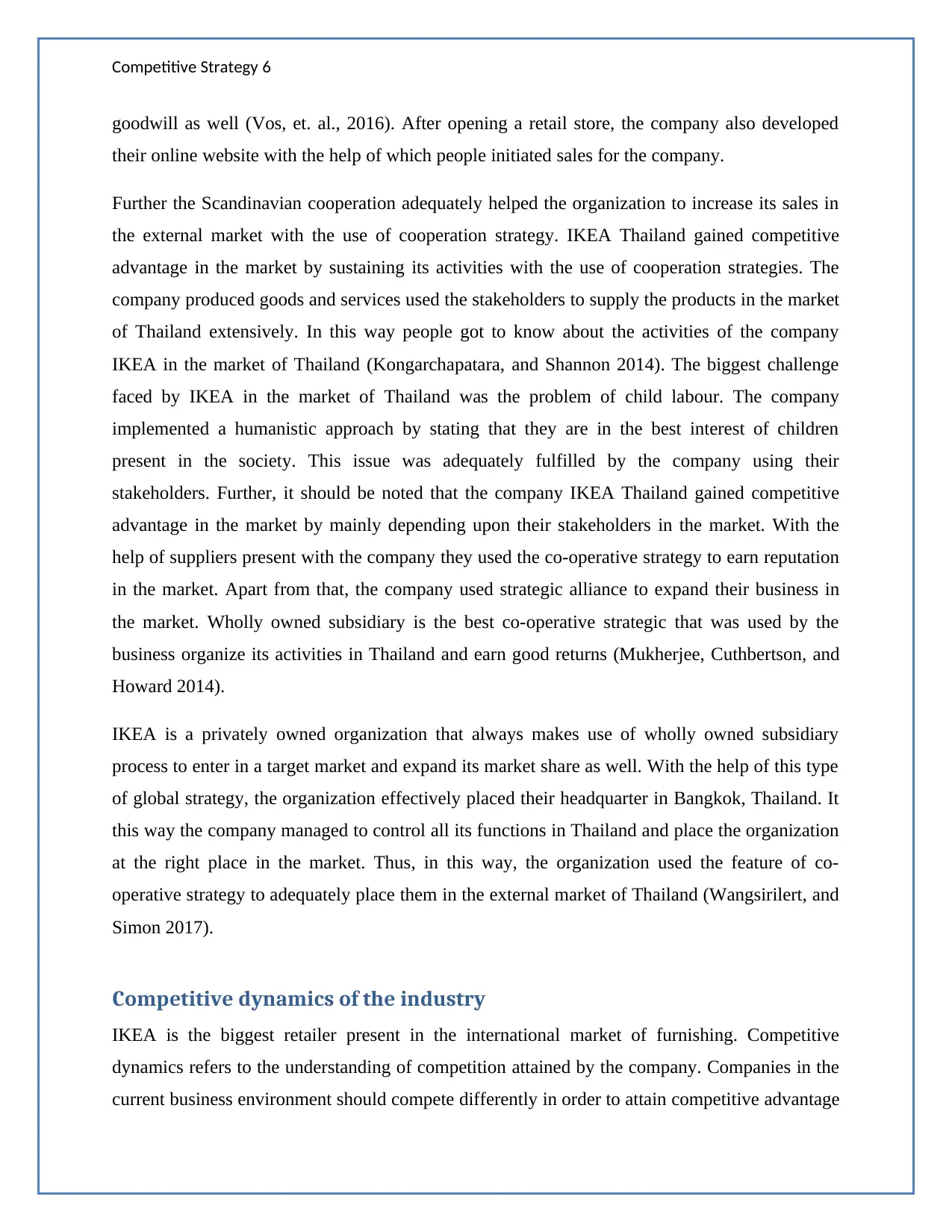
Competitive Strategy 6
goodwill as well (Vos, et. al., 2016). After opening a retail store, the company also developed
their online website with the help of which people initiated sales for the company.
Further the Scandinavian cooperation adequately helped the organization to increase its sales in
the external market with the use of cooperation strategy. IKEA Thailand gained competitive
advantage in the market by sustaining its activities with the use of cooperation strategies. The
company produced goods and services used the stakeholders to supply the products in the market
of Thailand extensively. In this way people got to know about the activities of the company
IKEA in the market of Thailand (Kongarchapatara, and Shannon 2014). The biggest challenge
faced by IKEA in the market of Thailand was the problem of child labour. The company
implemented a humanistic approach by stating that they are in the best interest of children
present in the society. This issue was adequately fulfilled by the company using their
stakeholders. Further, it should be noted that the company IKEA Thailand gained competitive
advantage in the market by mainly depending upon their stakeholders in the market. With the
help of suppliers present with the company they used the co-operative strategy to earn reputation
in the market. Apart from that, the company used strategic alliance to expand their business in
the market. Wholly owned subsidiary is the best co-operative strategic that was used by the
business organize its activities in Thailand and earn good returns (Mukherjee, Cuthbertson, and
Howard 2014).
IKEA is a privately owned organization that always makes use of wholly owned subsidiary
process to enter in a target market and expand its market share as well. With the help of this type
of global strategy, the organization effectively placed their headquarter in Bangkok, Thailand. It
this way the company managed to control all its functions in Thailand and place the organization
at the right place in the market. Thus, in this way, the organization used the feature of co-
operative strategy to adequately place them in the external market of Thailand (Wangsirilert, and
Simon 2017).
Competitive dynamics of the industry
IKEA is the biggest retailer present in the international market of furnishing. Competitive
dynamics refers to the understanding of competition attained by the company. Companies in the
current business environment should compete differently in order to attain competitive advantage
goodwill as well (Vos, et. al., 2016). After opening a retail store, the company also developed
their online website with the help of which people initiated sales for the company.
Further the Scandinavian cooperation adequately helped the organization to increase its sales in
the external market with the use of cooperation strategy. IKEA Thailand gained competitive
advantage in the market by sustaining its activities with the use of cooperation strategies. The
company produced goods and services used the stakeholders to supply the products in the market
of Thailand extensively. In this way people got to know about the activities of the company
IKEA in the market of Thailand (Kongarchapatara, and Shannon 2014). The biggest challenge
faced by IKEA in the market of Thailand was the problem of child labour. The company
implemented a humanistic approach by stating that they are in the best interest of children
present in the society. This issue was adequately fulfilled by the company using their
stakeholders. Further, it should be noted that the company IKEA Thailand gained competitive
advantage in the market by mainly depending upon their stakeholders in the market. With the
help of suppliers present with the company they used the co-operative strategy to earn reputation
in the market. Apart from that, the company used strategic alliance to expand their business in
the market. Wholly owned subsidiary is the best co-operative strategic that was used by the
business organize its activities in Thailand and earn good returns (Mukherjee, Cuthbertson, and
Howard 2014).
IKEA is a privately owned organization that always makes use of wholly owned subsidiary
process to enter in a target market and expand its market share as well. With the help of this type
of global strategy, the organization effectively placed their headquarter in Bangkok, Thailand. It
this way the company managed to control all its functions in Thailand and place the organization
at the right place in the market. Thus, in this way, the organization used the feature of co-
operative strategy to adequately place them in the external market of Thailand (Wangsirilert, and
Simon 2017).
Competitive dynamics of the industry
IKEA is the biggest retailer present in the international market of furnishing. Competitive
dynamics refers to the understanding of competition attained by the company. Companies in the
current business environment should compete differently in order to attain competitive advantage
Paraphrase This Document
Need a fresh take? Get an instant paraphrase of this document with our AI Paraphraser
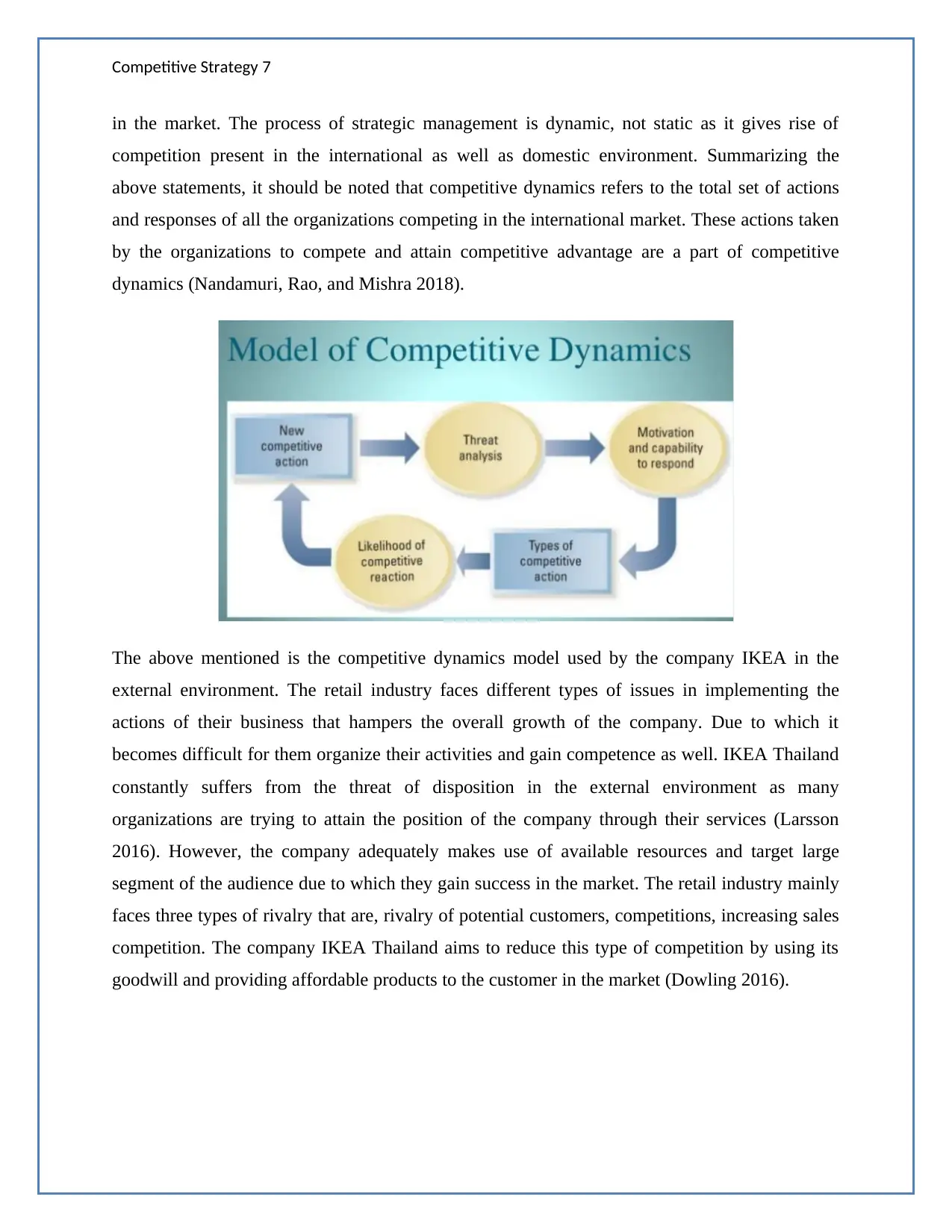
Competitive Strategy 7
in the market. The process of strategic management is dynamic, not static as it gives rise of
competition present in the international as well as domestic environment. Summarizing the
above statements, it should be noted that competitive dynamics refers to the total set of actions
and responses of all the organizations competing in the international market. These actions taken
by the organizations to compete and attain competitive advantage are a part of competitive
dynamics (Nandamuri, Rao, and Mishra 2018).
The above mentioned is the competitive dynamics model used by the company IKEA in the
external environment. The retail industry faces different types of issues in implementing the
actions of their business that hampers the overall growth of the company. Due to which it
becomes difficult for them organize their activities and gain competence as well. IKEA Thailand
constantly suffers from the threat of disposition in the external environment as many
organizations are trying to attain the position of the company through their services (Larsson
2016). However, the company adequately makes use of available resources and target large
segment of the audience due to which they gain success in the market. The retail industry mainly
faces three types of rivalry that are, rivalry of potential customers, competitions, increasing sales
competition. The company IKEA Thailand aims to reduce this type of competition by using its
goodwill and providing affordable products to the customer in the market (Dowling 2016).
in the market. The process of strategic management is dynamic, not static as it gives rise of
competition present in the international as well as domestic environment. Summarizing the
above statements, it should be noted that competitive dynamics refers to the total set of actions
and responses of all the organizations competing in the international market. These actions taken
by the organizations to compete and attain competitive advantage are a part of competitive
dynamics (Nandamuri, Rao, and Mishra 2018).
The above mentioned is the competitive dynamics model used by the company IKEA in the
external environment. The retail industry faces different types of issues in implementing the
actions of their business that hampers the overall growth of the company. Due to which it
becomes difficult for them organize their activities and gain competence as well. IKEA Thailand
constantly suffers from the threat of disposition in the external environment as many
organizations are trying to attain the position of the company through their services (Larsson
2016). However, the company adequately makes use of available resources and target large
segment of the audience due to which they gain success in the market. The retail industry mainly
faces three types of rivalry that are, rivalry of potential customers, competitions, increasing sales
competition. The company IKEA Thailand aims to reduce this type of competition by using its
goodwill and providing affordable products to the customer in the market (Dowling 2016).
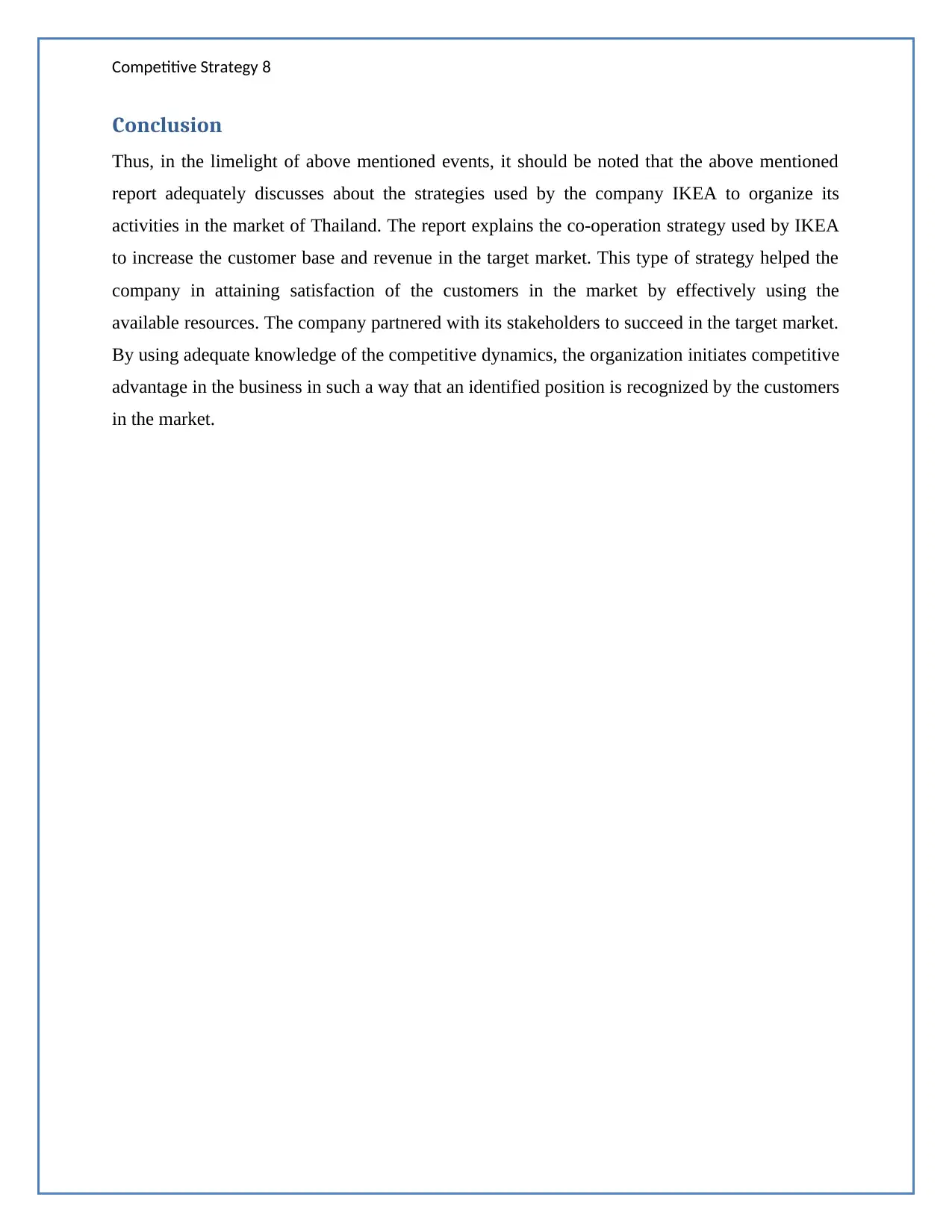
Competitive Strategy 8
Conclusion
Thus, in the limelight of above mentioned events, it should be noted that the above mentioned
report adequately discusses about the strategies used by the company IKEA to organize its
activities in the market of Thailand. The report explains the co-operation strategy used by IKEA
to increase the customer base and revenue in the target market. This type of strategy helped the
company in attaining satisfaction of the customers in the market by effectively using the
available resources. The company partnered with its stakeholders to succeed in the target market.
By using adequate knowledge of the competitive dynamics, the organization initiates competitive
advantage in the business in such a way that an identified position is recognized by the customers
in the market.
Conclusion
Thus, in the limelight of above mentioned events, it should be noted that the above mentioned
report adequately discusses about the strategies used by the company IKEA to organize its
activities in the market of Thailand. The report explains the co-operation strategy used by IKEA
to increase the customer base and revenue in the target market. This type of strategy helped the
company in attaining satisfaction of the customers in the market by effectively using the
available resources. The company partnered with its stakeholders to succeed in the target market.
By using adequate knowledge of the competitive dynamics, the organization initiates competitive
advantage in the business in such a way that an identified position is recognized by the customers
in the market.
⊘ This is a preview!⊘
Do you want full access?
Subscribe today to unlock all pages.

Trusted by 1+ million students worldwide
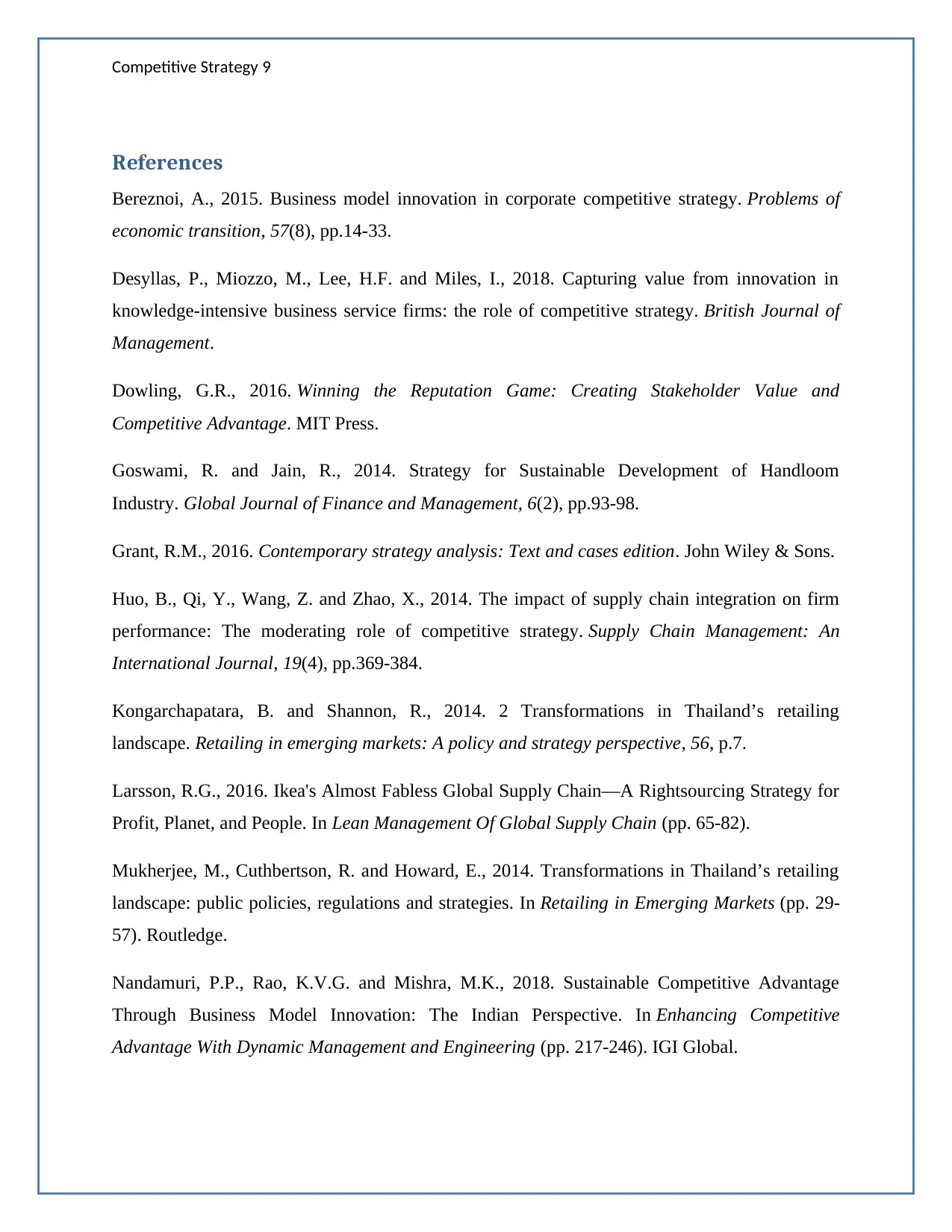
Competitive Strategy 9
References
Bereznoi, A., 2015. Business model innovation in corporate competitive strategy. Problems of
economic transition, 57(8), pp.14-33.
Desyllas, P., Miozzo, M., Lee, H.F. and Miles, I., 2018. Capturing value from innovation in
knowledge-intensive business service firms: the role of competitive strategy. British Journal of
Management.
Dowling, G.R., 2016. Winning the Reputation Game: Creating Stakeholder Value and
Competitive Advantage. MIT Press.
Goswami, R. and Jain, R., 2014. Strategy for Sustainable Development of Handloom
Industry. Global Journal of Finance and Management, 6(2), pp.93-98.
Grant, R.M., 2016. Contemporary strategy analysis: Text and cases edition. John Wiley & Sons.
Huo, B., Qi, Y., Wang, Z. and Zhao, X., 2014. The impact of supply chain integration on firm
performance: The moderating role of competitive strategy. Supply Chain Management: An
International Journal, 19(4), pp.369-384.
Kongarchapatara, B. and Shannon, R., 2014. 2 Transformations in Thailand’s retailing
landscape. Retailing in emerging markets: A policy and strategy perspective, 56, p.7.
Larsson, R.G., 2016. Ikea's Almost Fabless Global Supply Chain—A Rightsourcing Strategy for
Profit, Planet, and People. In Lean Management Of Global Supply Chain (pp. 65-82).
Mukherjee, M., Cuthbertson, R. and Howard, E., 2014. Transformations in Thailand’s retailing
landscape: public policies, regulations and strategies. In Retailing in Emerging Markets (pp. 29-
57). Routledge.
Nandamuri, P.P., Rao, K.V.G. and Mishra, M.K., 2018. Sustainable Competitive Advantage
Through Business Model Innovation: The Indian Perspective. In Enhancing Competitive
Advantage With Dynamic Management and Engineering (pp. 217-246). IGI Global.
References
Bereznoi, A., 2015. Business model innovation in corporate competitive strategy. Problems of
economic transition, 57(8), pp.14-33.
Desyllas, P., Miozzo, M., Lee, H.F. and Miles, I., 2018. Capturing value from innovation in
knowledge-intensive business service firms: the role of competitive strategy. British Journal of
Management.
Dowling, G.R., 2016. Winning the Reputation Game: Creating Stakeholder Value and
Competitive Advantage. MIT Press.
Goswami, R. and Jain, R., 2014. Strategy for Sustainable Development of Handloom
Industry. Global Journal of Finance and Management, 6(2), pp.93-98.
Grant, R.M., 2016. Contemporary strategy analysis: Text and cases edition. John Wiley & Sons.
Huo, B., Qi, Y., Wang, Z. and Zhao, X., 2014. The impact of supply chain integration on firm
performance: The moderating role of competitive strategy. Supply Chain Management: An
International Journal, 19(4), pp.369-384.
Kongarchapatara, B. and Shannon, R., 2014. 2 Transformations in Thailand’s retailing
landscape. Retailing in emerging markets: A policy and strategy perspective, 56, p.7.
Larsson, R.G., 2016. Ikea's Almost Fabless Global Supply Chain—A Rightsourcing Strategy for
Profit, Planet, and People. In Lean Management Of Global Supply Chain (pp. 65-82).
Mukherjee, M., Cuthbertson, R. and Howard, E., 2014. Transformations in Thailand’s retailing
landscape: public policies, regulations and strategies. In Retailing in Emerging Markets (pp. 29-
57). Routledge.
Nandamuri, P.P., Rao, K.V.G. and Mishra, M.K., 2018. Sustainable Competitive Advantage
Through Business Model Innovation: The Indian Perspective. In Enhancing Competitive
Advantage With Dynamic Management and Engineering (pp. 217-246). IGI Global.
Paraphrase This Document
Need a fresh take? Get an instant paraphrase of this document with our AI Paraphraser
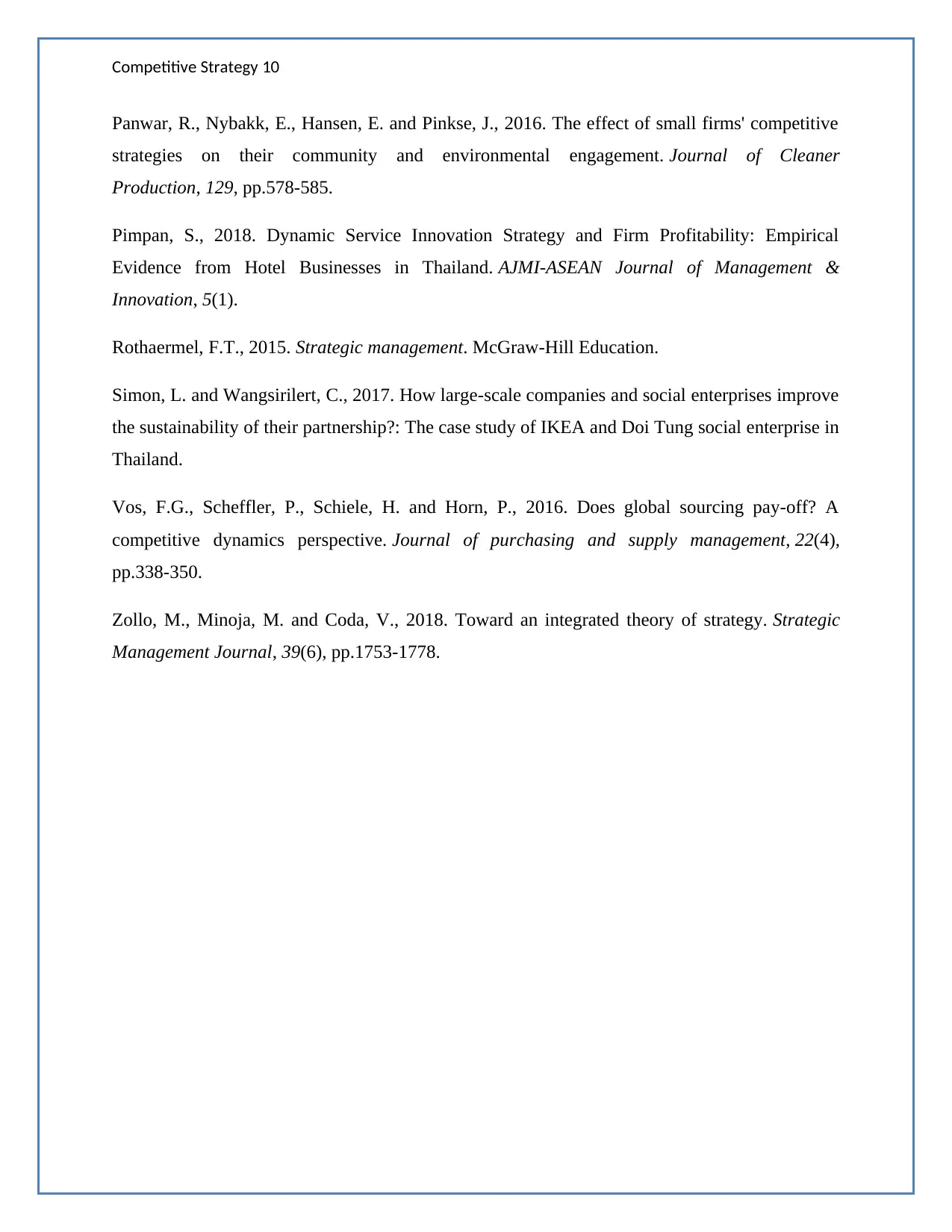
Competitive Strategy 10
Panwar, R., Nybakk, E., Hansen, E. and Pinkse, J., 2016. The effect of small firms' competitive
strategies on their community and environmental engagement. Journal of Cleaner
Production, 129, pp.578-585.
Pimpan, S., 2018. Dynamic Service Innovation Strategy and Firm Profitability: Empirical
Evidence from Hotel Businesses in Thailand. AJMI-ASEAN Journal of Management &
Innovation, 5(1).
Rothaermel, F.T., 2015. Strategic management. McGraw-Hill Education.
Simon, L. and Wangsirilert, C., 2017. How large-scale companies and social enterprises improve
the sustainability of their partnership?: The case study of IKEA and Doi Tung social enterprise in
Thailand.
Vos, F.G., Scheffler, P., Schiele, H. and Horn, P., 2016. Does global sourcing pay-off? A
competitive dynamics perspective. Journal of purchasing and supply management, 22(4),
pp.338-350.
Zollo, M., Minoja, M. and Coda, V., 2018. Toward an integrated theory of strategy. Strategic
Management Journal, 39(6), pp.1753-1778.
Panwar, R., Nybakk, E., Hansen, E. and Pinkse, J., 2016. The effect of small firms' competitive
strategies on their community and environmental engagement. Journal of Cleaner
Production, 129, pp.578-585.
Pimpan, S., 2018. Dynamic Service Innovation Strategy and Firm Profitability: Empirical
Evidence from Hotel Businesses in Thailand. AJMI-ASEAN Journal of Management &
Innovation, 5(1).
Rothaermel, F.T., 2015. Strategic management. McGraw-Hill Education.
Simon, L. and Wangsirilert, C., 2017. How large-scale companies and social enterprises improve
the sustainability of their partnership?: The case study of IKEA and Doi Tung social enterprise in
Thailand.
Vos, F.G., Scheffler, P., Schiele, H. and Horn, P., 2016. Does global sourcing pay-off? A
competitive dynamics perspective. Journal of purchasing and supply management, 22(4),
pp.338-350.
Zollo, M., Minoja, M. and Coda, V., 2018. Toward an integrated theory of strategy. Strategic
Management Journal, 39(6), pp.1753-1778.
1 out of 11
Related Documents
Your All-in-One AI-Powered Toolkit for Academic Success.
+13062052269
info@desklib.com
Available 24*7 on WhatsApp / Email
![[object Object]](/_next/static/media/star-bottom.7253800d.svg)
Unlock your academic potential
Copyright © 2020–2025 A2Z Services. All Rights Reserved. Developed and managed by ZUCOL.





